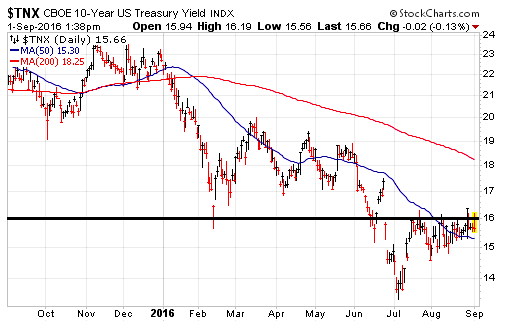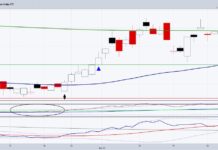If there is one major theme that pervades the financial markets this year, it’s the shift from stocks to treasury bonds. You can romanticize about the momentum in gold stocks. You can peek over at emerging market strength, but nothing compares to the pervasive re-allocation of global assets.
According to Investment Company Institute data released this week, stock mutual funds and ETFs recorded another $6.6 billion of weekly outflows. Bond funds added $6.4 billion of new money. Their eighth consecutive week of inflows.
Reuters is reporting that in just the first six months of 2016, investors pulled $64 billion from stocks and added $104 billion to bonds based on ICI data. That’s a big vote of confidence towards the continued trend of falling interest rates and thirst for yield.
The chart below of the 10-Year Treasury Bonds Note Yield (INDEXCBOE:TNX) depicts this trend in earnest. Things are now starting to get intriguing after a sharp bounce off the lows in July and a consolidation phase in August.
The 1.6% area on the chart is a key level I have mentioned several times in the past. It’s also one that has been continually tested over the last several weeks. A break higher in treasury yields would mean lower prices for treasury bonds.
I tend to think of fund flows as an extension of sentiment, but it’s real money. It’s the difference between what people say they are going to do and what they actually do.
The data indicates that investors have been fleeing stock funds for virtually the entire year and transitioning to more “defensive” areas like treasury bonds. That has helped stimulate momentum throughout virtually every sector of the fixed-income market. Emerging markets, high yield, and Treasuries have been the primary recipients of that strength.
The funny thing is that stocks have also been rising in tandem as well. The difference is that many investors are selling down their stock allocations in anticipation of some sort of correction, crash, or slow decline in equities.
If I had to pick one asset class that was over-loved and over-owned right now, it would be bonds.
That doesn’t mean you should sell all your fixed-income holdings or dramatically alter your asset allocation at this juncture. However, it does mean that you should be closely evaluating your portfolio’s sensitivity to interest rates and potentially credit risk as well. This task may uncover some areas that could use a little bit of fine-tuning.
I gave some tips on how to accomplish this task here.
This also extends to investment classes outside of conventional fixed-income. Preferred stocks, REITs, and utilities are a few areas that are traditionally negatively correlated with bond yields. That doesn’t mean they will come crashing down if interest rates rise, but they may under perform your expectations if we undergo a meaningful trend change.
Like any good income investor, I am keeping an open mind to multiple scenarios with a balanced approach to portfolio management. Prudence suggests pairing back on areas showing undo exuberance and waiting patiently for fresh opportunities to arise.
Thanks for reading.
Twitter: @fabiancapital
Read more on Dave’s Blog.
The author of his clients may hold positions in mentioned securities. Any opinions expressed herein are solely those of the author, and do not in any way represent the views or opinions of any other person or entity.









